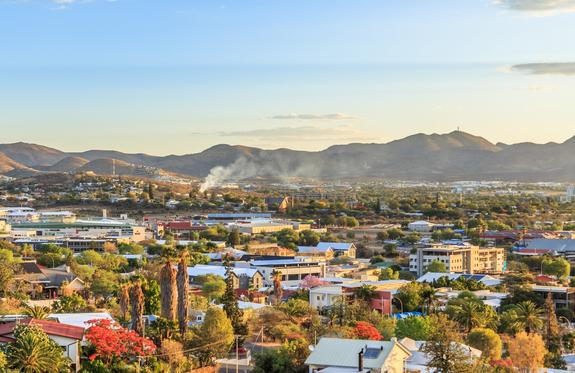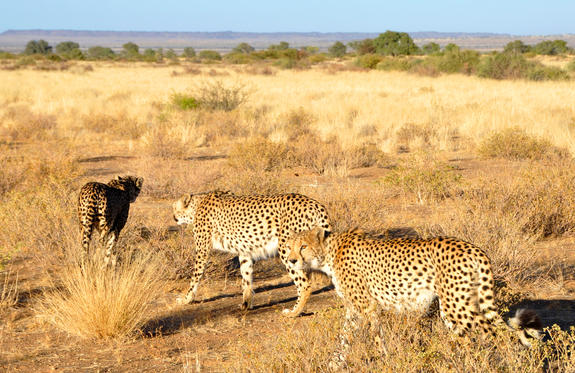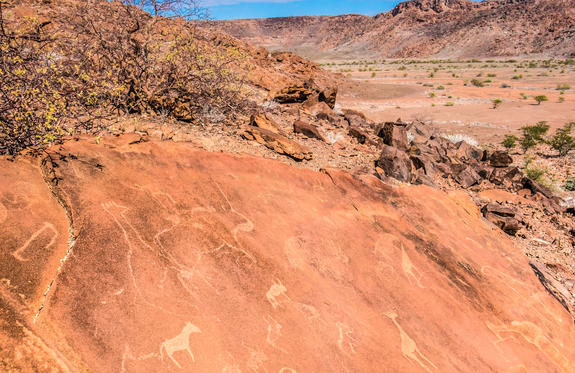Located in southwestern Africa, Namibia boasts a well-developed infrastructure, some of the best tourist facilities in Africa, and an impressive list of breathtaking natural wonders. Visitors can explore the capital of Windhoek and discover the lovely coastal town of Swakopmund boasting remnants of the country’s German influence, reflected in the architecture, culture, cuisine and the annual Oktoberfest celebrations. To properly appreciate this extraordinary country, you will have to venture out of the cities to explore the remarkable natural landscapes Namibia has to offer. These include: the impressive Fish River Canyon; the vast Etosha National Park teeming with abundant wildlife, such as lions, desert-adapted elephants and the Hartmann's Mountain Zebra; the hauntingly beautiful Kalahari Desert; and of course the Namib Desert stretching for over 2000 km along the magnificent Atlantic Coast. Namibia is an ideal destination for travellers seeking an unforgettable African experience in a uniquely beautiful untamed wilderness.

Windhoek is the capital of Namibia, located in the central highlands of the country. South of the city, the sprawling Heroes' Acre war memorial commemorates Namibia's independence in 1990. On a hill in the city center stands the Old Fort, dating back to the 1890s, which was a former military headquarters with historical exhibits, and the Independence Memorial Museum. Colonial influences are visible in nearby buildings such as the Lutheran Christ Church made of sandstone, as well as in the Victorian buildings lining the streets of Windhoek.
THINGS TO DO
- National Museum Namibia (www.museums.com.na/museums/ windhoek/national-museum-of-namibia)
- Independence Memorial Museums (www.museumscom.na/ museums/wind-hoek/independence-museum)
- Visit the Christ Church
- Tour through the Katutura Township (www.mwiyatours.com)
UNSERE RESTAURANT TIPPS
- Joe's Beerhouse (www.joesbeerhouse.com)
- Daisho Sushibar (www.daishosushibar.com/menu)
- ButcherBlock (www.butcherblocksteakhouse.com)
- Leo’s at the Castle (www.heinitzburg.com)
TIPS
Stellenbosch Wine Bar & Bistro: The bistro-style menu showcases the fresh and diverse flavors of Namibia. The focus is on prime Namibian cuts of meat, perfectly grilled over an open flame, accompanied by a selection of delicious homemade sauces and sides. Complete your meal with a quality wine from the excellent wine list.
Tel.: +264 61 309 141 \ Web.: www.thestellenboschwinebar.com

Otjiwarongo is a charming town that offers visitors an authentic Namibian experience. The town has a relaxed and friendly atmosphere, and the locals are known for their hospitality and warmth. Otjiwarongo often serves as a starting point for safaris and excursions to the surrounding wildlife reserves. In the town itself, you will find hotels, restaurants, shops, and markets where visitors can purchase local products and handicrafts.
One of the main attractions near Otjiwarongo is the Waterberg Plateau, an impressive Waterberg Mountain surrounded by a national park. Here, visitors have the opportunity to hike, observe wildlife, and enjoy breathtaking views from the top of the plateau.
Otjiwarongo is also home to the AfriCat Foundation Carnivore Conservation Centre, an organization dedicated to the protection and preservation of predators in Namibia. Visitors can tour the facility, learn about their work, and even have the chance to see predators such as cheetahs and leopards up close. The area around Otjiwarongo is dotted with numerous wildlife reserves and private sanctuaries, which are home to a variety of wildlife, including elephants, giraffes, zebras, rhinos, antelopes, various predator species, and a rich birdlife.
Although Otjiwarongo is not one of Namibia's largest or most famous cities, it has its own charm and offers an authentic experience of Namibian culture and nature. It is a place where you can admire the beauty of the landscape, discover wildlife, and experience the warm hospitality of the locals.
CONSERVATION PROGRAMS IN OTJIWARONGO
In addition to the AfriCat Foundation, Otjiwarongo is also home to the Cheetah Conservation Fund, an organization dedicated to the protection and preservation of cheetahs worldwide through research, education, and community-based conservation efforts.

The Onguma Game Reserve is a popular destination for wildlife viewing, located adjacent to the eastern side of Etosha National Park in Namibia. Spanning an area of about 34,000 hectares, it offers visitors a unique safari experience.
Onguma is renowned for its diverse landscape, which includes open plains, mopane woodlands, and dense bushland. The reserve is home to a wide variety of wildlife species, including elephants, lions, leopards, giraffes, zebras, wildebeests, and numerous bird species. Visitors have an excellent opportunity to observe these fascinating animals in their natural environment.
One of the main attractions of the Onguma Game Reserve is its immediate proximity to Etosha National Park. The eastern side of Onguma borders Etosha, allowing wildlife to roam freely between the two areas. This free movement enhances the chances of spotting a wide range of animals.
Another highlight of Onguma is the strategically positioned photographic hides at waterholes. These hides offer photographers and wildlife enthusiasts a fantastic opportunity to capture stunning close-up images of wildlife without disturbing their natural behavior.
In addition to wildlife experiences, Onguma Game Reserve also offers cultural encounters and opportunities for relaxation. Cultural tours to nearby villages provide insights into the traditions and customs of local communities, while wellness facilities and swimming pools in the lodges allow guests to unwind and rejuvenate after exciting game drives.
Overall, Onguma Game Reserve provides a remarkable blend of wildlife adventure, cultural exploration, and relaxation, making it an ideal destination for nature lovers and safari enthusiasts.

Located just south of the boundary of Etosha National Park in northwestern Namibia, Etosha South makes up the southern region of this wild paradise. The area is comprised of a collection of world class private game reserves. The national park can be accessed via the southern entrance at Andersson’s Gate. Visitors can catch a glimpse of a variety of wildlife including: lion, giraffe, elephant, white and black rhino, and a multitude of plains game. Popular activities include: enjoying an open 4x4 safari with an expert guide, half day or full day drives with the option of a picnic lunch with wine on the full day game drive.

Twyfelfontein, located in Namibia’s Kunene Region, is a site of extraordinary cultural and historical significance. Known for its rich collection of over 2,500 prehistoric rock engravings, Twyfelfontein is one of Africa’s most important archaeological sites and a UNESCO World Heritage site.
Visitors can explore the beautifully preserved petroglyphs depicting animals, humans, and mysterious geometric patterns, thought to have been created by hunter-gatherers over 6,000 years ago. The red sandstone rock formations, set against the backdrop of rugged desert landscapes, add to the region's dramatic natural beauty.
In addition to its archaeological significance, Twyfelfontein offers visitors the chance to see rare desert-adapted wildlife, including elephants, giraffes, and oryxes. Guided tours are available, giving travelers the opportunity to delve deeper into the history and culture of this fascinating area.
Nearby Attractions:
- The Petrified Forest: A unique site with ancient fossilized trees.
- The Organ Pipes: Striking dolerite columns formed by volcanic activity.
- Burnt Mountain: A dark, eerie-looking hill with unusual geological features.
Whether you are a history enthusiast or a nature lover, Twyfelfontein provides a captivating experience that combines the ancient past with the rugged beauty of Namibia's desert wilderness.

Swakopmund is a charming coastal town and a popular destination for tourists from all over the world. The city blends German colonial architecture with African flair and offers a variety of activities and attractions. Situated on the coast on the edge of the Namib Desert, the city provides a wonderful view of the Atlantic Ocean. The towering sand dunes and rugged coastline offer numerous opportunities for activities such as sandboarding, quad biking, and dune hiking. Swakopmund is also renowned for its excellent restaurants and cafes, where you can enjoy both Namibian and international cuisine. Be sure to taste local specialties made from fresh fish and seafood.
THINGS TO DO
- Dolphin Cruise (mola-namibia.com)
- Tommy’s Living Desert Tour (livingdeserttours.com.na)
- Excursion toWalvis Bay
- Fat Bike Tours (https://www.swakopfatbiketours.com/)
RESTAURANT TIPPS
- The Tug (www.the-tug.com)
- Kücki’s Pub (www.kuckispub.com)
- Jetty 1905 (www.lighthousegroup.com.ca)
- The Wreck Restaurant (www.the-wreck.com)
- Village Cafe (www.villagecafenamibia.com)
OUR TIP
Quad biking with Desert Explorer: Looking for a bit of adrenaline? Then join Desert Explorer on a tour through the fascinating dune landscape around Swakopmund. One to three-hour quad bike tours are offered with experienced guides (www.namibiadesertexplorers.com).

As there is no accommodation at Sossusvlei, visitors to this desert wilderness are likely to end up staying at Sesriem, 65 kilometres away, where camps and lodges serve as a base from which to explore the dunes. Sesriem Canyon, a deep chasm carved through the rocks by water, is a striking natural feature of the area that is best explored on foot. Stony walls rise up sharply on both sides of the canyon, while birds roost in its crags and lizards dart along the ledges. The canyon’s name was coined when early settlers used it as a water source, using six lengths of leather (‘ses riem – six thongs) tied together to lower buckets into the water at the base of canyon.)

The Kalahari Desert, despite its name, receives a small amount of annual rainfall that is sufficient to support the growth of grasses and thorny shrubs. This vegetation provides food and shelter for the diverse wildlife that has adapted to this harsh environment.
The most characteristic feature of the Kalahari is its majestic sand dunes, which glow in a warm, reddish hue. These dunes stretch across a vast area, creating an otherworldly and impressive landscape. The sight of the dunes at sunrise and sunset offers a fascinating play of shadows and brings the colors of the desert to life. The silence and vastness of the Kalahari Desert give visitors a sense of seclusion and tranquility. Horizons stretch endlessly into the distance as you wander through open plains or along sandy paths.
The Kalahari Desert is home to a variety of wildlife adapted to the extreme conditions. Lions that hunt in the desert are known for their impressive manes and their ability to successfully hunt in the thorny bushland. Cheetahs, capable of breathtaking speeds, use the open grasslands of the Kalahari to chase their prey. Leopards, agile climbers, stalk their prey from trees and disappear skillfully into the dense bush. Hyenas roam the desert, playing a crucial role in scavenging carcasses, while meerkats, with their upright postures and curious behaviors, captivate onlookers. Springboks, with their distinctive ability to leap great distances, enliven the landscape, while gemsbok, with their long, curved horns, majestically traverse the plains.
ANIMALS IN THE DESERT
Lions | Cheetahs | Leopards | Hyenas | Meerkats | Springboks | Oryx | Ostriches | Jackals | Bats | Scorpions | Kudu Antelopes | Giraffes | Porcupines




